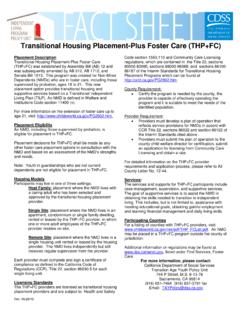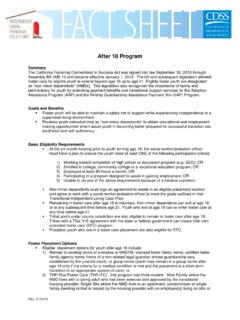Transcription of TABLE OF CONTENTS - ALSASHOW
1 1 TABLE OF CONTENTS in Judging ..3 Characteristics of a Good Classes: Criteria: Positive Traits & Negative of Placing Conformation: Llama Parts of the Parts of the : Judging Classes: Obstacle Class of Scoring Criteria Handler Animal & Equipment Reasons: Procedure Note Taking of Notes for Oral 2 INTRODUCTION Ever wonder why a particular animal places first (or last)? Ever wonder why somebody chooses to buy one animal over another? Participation in the ALSA youth Judging Program can help you develop the knowledge to answer these questions yourself.
2 By participating in Judging Contests, you will develop skills and train your eyes to observe all aspects of animals and make comparative selections. This will provide you with a sound basis for development within the lama community and may be the spark that leads to your being an ALSA Judge in the future. The basic principles of conformation and soundness apply to all livestock. Although this program is specifically geared to llamas and alpacas, the general knowledge to be gained from participating will help you in evaluating whatever livestock you choose. To excel at this, or any livestock judging, you must have a strong desire to know and understand the animal and devote time and energy studying the materials.
3 The skills involved in thinking clearly, making decisions knowledgeably and defending accurately those decisions, with concise, orderly reasons, help develop confidence and maturity that will assist you in all future endeavors. We encourage any group of young people, with parents and leaders, to use this manual towards the end of holding youth Judging Clinics and Judging Contests, either as stand alone events or in conjunction with local, regional, state and national stock shows. Llama associations, as well as 4-H Clubs and FF A Chapters, will find this program in keeping with their goals of activity, growth, development of skills and rewards for our youth .
4 Through judging, you can learn to: use correct terminology analyze animals accurately describe and compare animals arrive at definite decisions support decisions with clear and concise statements. 3 ESSENTIALS OF JUDGING. Judging is: 1. Evaluating a lama on its type, quality conformation, movement, sound ness, fiber quality and disposition relative to: a. Its intended purpose b. How closely it approaches the ideal lama 2. Being able to assess the relative excellence of two or more lamas. Judging clinics, organized by 4-H Groups, FFA Chapters, or interested llama and alpaca associations are designed to give.
5 Participants knowledge of conformation and soundness of animals as well as methods, rules and other essentials of judging. Visits to farms, shows and auctions Will give you opportunities to see and evaluate larger numbers of lamas. Remember, you re not looking for how they are alike, but how they re different. You ll learn what is a repre-sentative, sound, conformationally correct lama. In all our judging classes, there will be four lamas. Because judging is based on observation, analysis and decision-making, you must first know what you re looking for. You will learn the parts of the animal and how important each part is in relation to the whole, based on anatomy and function.
6 There are no clear-cut, right/wrong, and black-white answers in judging. You must: 1. Know what you re looking at, and for, and why. 2. Be honest, open-minded and fair. 3. Learn to balance your ideal with the best over-all package, faults and all. 4. Practice, practice, practice. 4 CHARACTERISTICS OF A GOOD JUDGE 1. Judges are knowledgeable. They know what type of lama they re look-ing for: what their ideal is.. They recognize good free movement: how the feet and legs are supposed to work together. They know where to look for faults, unsoundness and blemishes. 2. Judges have keen powers of observation.
7 They know how to look at a class and where to stand to see what they need to see. They have learned to observe and evaluate the whole lama and all his parts. 3. Judges have learned to make comparisons. They compare each lama to their ideal as well as to the other lamas in the class. They know how important a fault, or good point, is and how strongly to consider it in making their decision. They have learned to see not only that they have a difference, but how different it is. 4. Judges are able to make decisions quickly. Taking a long time to make a decision may lead the audience and the entrants to think you re not sure.
8 Developing your. Knowledge of lamas, your powers of observation, and your ability to make comparisons (the first three (characteristics) should enable you to make timely, informed decisions. 5. Judges defend placings with reasons. A good set of reasons is dependent on: a. accurate observation. b. an effective vocabulary of relevant terms. c. an orderly system. d. the ability to convey your thoughts in a convincing manner. (In this program, juniors will give reasons in writing in response to questions. Intermediates will give reasons orally based on, but without the benefit of notes.))
9 6. Judges possess integrity. Never let anything other than the lamas in your class influence your decisions. The handler (unless you are judging a performance class), the audience, or your own knowledge of how a particular animal has placed previously should be neither a positive nor negative factor in your decision making process. 7. Judges are always positive. Remember that your job in the show ring is to select the best lama in the class, not the worst. You must spend a lot of time learning the correct parts of the lama and how they interact. But you must also learn about the deviations from these norms.
10 Although you must discuss faults in your reasons, you must give equal weight to the positive characteristics that offset these faults.. 5 HALTER CLASS DEFINITIONS Soundness: Free from flaw, defect, disease or injury. Unsoundness :Physical disability that prevents the animal from being used for the purpose intended. Conformation: Appropriate arrangement of body parts. Balance: Proportionate shape or contour of the animal.. A noticeable imperfection that does not affect the function, purpose or soundness of an animal. Movement: A reflection of the balance and conformation of an animal. Blemish: Disposition: Mental attitude of an animal showing willing responsiveness.






